Abstract
The review summarizes recent experimental results of studying heat transfer on rough surfaces synthesized by plasma. The plasma-surface interaction leads to the stochastic clustering of the surface roughness with a high specific area breaking the symmetry of the virgin surface of the initial crystalline materials. Such a surface is qualitatively different from the ordinary Brownian surface. The micro- and nanostructured surface consist of pores, craters, and nanofibers of size from tens of nanometers to tens of microns, which can provide new heat transfer properties related to a violation of the symmetry of the initial materials. In recent years, new results have been obtained in the study of heat transfer during phase change on plasma-modified surfaces in relation to energy, chemical, and cryogenic technologies. The objective of the review is to describe the specific structure of refractory metals after high-temperature plasma irradiation and the potential application of plasma processing of materials in order to create heat exchange surfaces that provide a significant intensification of two-phase heat transfer. Refractory metals with such a highly porous rough surface can be used as plasma-facing components for operation under extreme heat and plasma loads in thermonuclear and nuclear reactors, as catalysts for hydrogen production, as well as in biotechnology and biomedical applications.
1. Introduction
In fusion plasma devices, high-temperature plasma produces intense erosion of plasma-facing materials, evaporation, redeposition of eroded materials, and a surface structure reformation breaking the symmetry of the virgin surface of initial crystalline materials. Such several multiscale effects lead to a specific surface clustering. As a result of agglomeration under extremely high thermal loads and the collective effects of plasma and material flows, unique stochastic topography and hierarchy of material granularity (self-similarity) are formed on the surface at scales from nanometers to millimeters [1,2,3]. The problem relates to the growth of materials with complex structures, which are neither crystals nor amorphous bodies in the classical sense. The topology of such surfaces is strictly different from any other clustering of materials produced in non-plasma devices or solidification observed earlier. The role of nanoscales in such processes under plasma influence is important in the dendritic growth of various structures and aggregation-based growth of branched structures or hierarchical granularity of fractal topology. The shape and hierarchical structure of such a surface can be classified within the framework of fractal geometry. Such structures, called fractals, are known in nature (for example, the structure of trees, and corals).
Such materials with unique roughness and porosity are attractive for use in modern cooling and thermal stabilization components in devices at high thermal loads of 1–10 MW/m2. The use of materials with a rough surface allows reducing the heat exchange area in order to increase the efficiency of equipment in energy and chemical technologies and in electronic components. Recently, new results have been obtained using modern technologies for surface modification in order to improve the characteristics of heat transfer during phase transitions, for which the change in the characteristic properties of the surface is paramount: the structure of roughness, porosity, and wettability. Currently, there is a competitive selection of technologies that allow obtaining the maximum intensification of heat transfer, and interest in the possibilities of surface modification by plasma treatment has practical applications. Plasma irradiation of the surface allows changing the entire set of influencing parameters.
The motivation for the review is the need to analyze the latest research results on two-phase heat transfer on rough surfaces modified by plasma, a comparison of the results obtained, emphasizing the choice of a method of surface modification by plasma, which has the potential for practical application.
In this review, we focus on the above-mentioned effects of rough surfaces synthesized by plasma related to a violation of the symmetry of the initial materials, especially on nanostructured high-porous and fuzz-like surface growth under high-temperature plasma irradiation. We review the recent experimental results of studying heat transfer on rough surfaces synthesized by plasma. The comprehensive focus is on the findings of the significant intensification of two-phase heat transfer on such materials. In the latter part, the pool boiling heat transfer enhancements on the surface treated by plasma will be discussed.
2. Rough Surfaces Synthesized by Plasma
2.1. The Plasma-Surface Interaction
High-temperature plasma in thermonuclear fusion devices with magnetic plasma confinement (tokamaks, linear devices, and others) has complex nonlinear properties with self-organization [4]. The properties of magnetized plasma in fusion devices differ from the properties of low-temperature plasma. Strong plasma turbulence in such devices causes degradation of the magnetic plasma confinement and leads to enhanced plasma transport across the confined magnetic field [5,6]. As a result of this process, hot plasma enters the plasma-facing walls of the device chamber. Such plasma fluxes of the powerful heat load of the order from 0.1 to 10 MW/m2 on average (and pulse load of up to 1–2 GW/m2) [7,8,9] lead to strong erosion and degradation of the material surfaces of the wall facing the plasma. The eroded material enters the near-wall plasma (edge plasma), affecting the plasma-surface interaction. Thus, the plasma-surface system acquires the properties of a system near criticality with the properties of self-organization. The properties of near-wall plasma and turbulence in fusion devices were studied in detail (see recent reviews [5,6] and references therein). In the edge plasma, instability of the drift-dissipative type leads to strong fluctuations in plasma density and electric fields. In the near-wall plasma, charged particles (ions and electrons) move in turbulent electric fields generated by drift-dissipative (electrostatic) turbulence. The amplitude of the electric field is typically from ~1 to ~50 V/cm, and the fluctuation frequency range is from ~1 to ~1000 kHz. The wavelength is from ~1 to ~50 mm [5,6]. Under such conditions, charged particles move in turbulent eddies with a velocity from ~0.1 to ~1 km/s. In fusion devices, near-wall plasma turbulence is characterized by super diffusion, intermittency, and non-Gaussian statistics [10,11,12,13,14]. A feature of high—temperature plasma in fusion devices is a distribution function of turbulent pulsations with the so-called non-Gaussian statistics, which characterizes intermittency. Numerous experimental measurements have demonstrated that fluctuations in electric field and density in the near-wall plasma of fusion devices have non-Gaussian statistics. This property leads to the formation of flight trajectories of ions and electrons during diffusion: the trajectories of plasma particles in turbulent electric fields are not Brownian motion (classical diffusion) but stochastic Levy-type motion with a predominant contribution of flight trajectories. This means that the movement of ions in the near-wall plasma is not a classical Brownian motion (classical diffusion). When such flows are deposited on the material surface, conditions arise for the growth of inhomogeneous structures on the surface facing the plasma. As a result of surface agglomeration under extremely high thermal loads and the collective effects, a unique stochastic topography and hierarchy of material granularity (self-similarity) on scales from nanometers are formed on the plasma-facing surface.
2.2. Stochastic Clustering of the Surface Roughness
The material irradiated with high-temperature plasma in fusion devices has an inhomogeneous structure deviating from the trivial stochastic granularity (of the Brownian surface), Figure 1. It obeys high porosity and high specific area. Stochastic clustering of the surface under the action of random forces generated by near-wall plasma leads to the growth of materials with a complex structure that are neither crystals nor amorphous solids considered by classical solid-state theory.

Figure 1.
SEM micrograph of the tungsten surface after plasma irradiation in plasma facility QSPA-T. Zoom of structure is shown.
The granularity of materials irradiated with plasma is observed from nanoscales to macroscales ([1,2,3]; see Figure 1 and Figure 2). It is known that nanostructures (for example, nanocrystallites), due to their mobility and adaptability in a disordered solid provide scale invariance of the distribution of stress fields at the microscopic and mesoscopic levels. It leads to the scale invariance (hierarchical self-similarity) of the structure [1,2,3].
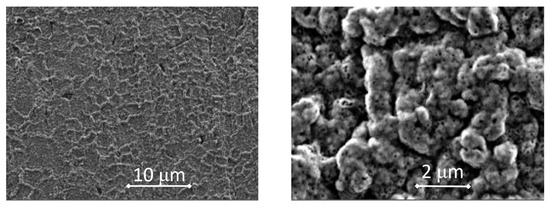
Figure 2.
SEM-micrography of the titanium surface after plasma irradiation in PLM plasma device [40].
The shape and hierarchical structure of such structures can be classified within the framework of fractal geometry. Such structures, called fractals, are known in nature (for example, the structure of trees, corals, etc.). The growth of such structures is regulated by the universal instability of the growth of interface layers (see, e.g., [15,16]).
The growth of the stochastic structure of materials during deposition from the volume to the surface or the interface dynamics is reviewed in the literature widely (see, e.g., [3]).
In vapor deposition, molecular beam epitaxy, etc. [16], fractal surface growth is observed in the deposition process where the agglomerated particle dynamics on large spatio-temporal scales are regulated by several driven and damping growth mechanisms (elementary processes). In nuclear fusion devices, the material surfaces are modified under a high-temperature plasma load.
The problem of fractal growth is treated by nonlinear Equations (e.g., Kardar-Parisi-Zhang Equation [17,18]) describing effects from competing for elementary processes. In order to describe irregular structures observed in solids and agglomerates of various scales, kinetic models based on the Smoluchowski kinetic Equation [19,20] are used. The theoretical treatment (based on Smoluchowski Equation, etc.) has shown that scale invariance is influenced by the statistics of the agglomerating particle dynamics.
In order to describe the stochastic aggregation process, the standard theoretical model based on Smoluchowski kinetic Equation is used (see [19,20]), considering the interaction of two particles (or clusters) with masses m1 and m2 forming a new particle (cluster) with mass m = m1 + m2. It is considered that large particles (clusters) do not decay. The Equation for the concentration N(m,t) (see [20]):
In (1), the last two terms are the source (incoming particles of mass m0 with the flux J0) and the sink (removal of particles of mass M with a flux J). The kernel K(m1,m2) and the factor Λ regulate the rate of interaction of clusters (particles).
In the literature the kernels with self-similarity characteristics are considered (see [20]):
K(hm1,hm2,hm) = hηK(m1,m2,m), K(m1,m2)~m1μm2ν, μ + ν = η.
Indexes μ and ν are related to Hurst exponents, which were found in experiments. Typical Hurst exponents are in the range of 0.55–0.9.
The redistribution of mass between clusters during the agglomeration (the sticking/decay of clusters of different sizes) is analogous to the energy transfer in the turbulence cascade of fluid flow. A formal analogy between the Equation for the nonlinear fragmentation-aggregation process and the kinetic Equation describing 3-wave turbulence is discussed (see, e.g., [20]), resulting in the power-law spectrum, which is considered in the Kolmogorov-Zakharov approach [21,22,23]. The kinetic Equation with the kernel (2) can be treated by using the theory of A.N. Kolmogorov [5,21] to describe the distribution of clusters in scales observed in experiments. In order to simplify the problem; it is necessary to use experimental data on the self-similarity scaling of stochastic surface relief. It is important to use the scaling exponents and the fractal dimensions observed in experiments. The formation of cluster fractality is associated with a universal cascade mechanism for the formation of fracture centers at a high degree of nonequilibrium (high density of absorbed energy) in the system when acoustic unloading of the irradiated object does not provide relaxation.
The estimated fractal dimension df of the irradiated material surface is in the range of 2.05–2.35 [1,2], similar values of the fractal dimension found in solids with an irregular structure, e.g., silicon aggregates (df = 2.27–2.65), quasi-crystals, see [24,25], metallic glasses (df = 2.31).
2.3. The Micro–and Nanostructured Surfaces
2.3.1. Cauliflower-like Surfaces
After irradiation with high-temperature plasma in fusion devices, the materials acquire a stochastic surface structure. Such experiments were carried out on tokamaks [1,2,3,26,27,28,29,30,31,32,33], QSPA powerful plasma accelerator facility [2,3,34], and linear plasma devices used for testing and treatment of refractory materials [35,36,37,38]. Experiments in such devices provide a powerful plasma-thermal load on the material components of the wall facing the plasma. Plasma energy loading on the wall material in fusion devices ranges from 0.1 to 10 MW/m2 in quasi-stationary discharges. In tokamak discharges with instabilities (ELMs of 0.1–1 ms duration), such a load on the material can reach 1 GW/m2 or more. Such a load is inhomogeneous in space and unstable in time. Instabilities of the near-surface plasma can lead to localized pulsed jets and bursts, which leads to pulsed local overheating of the material on a scale from 1 micrometer to several centimeters. Under the influence of such loads, the materials of the wall components facing the plasma are eroded and melted, leading to the formation of an irregular stochastic surface.
Inhomogeneous stochastic clustering of the surface was found for materials with different chemical compositions and initial crystal structures (tungsten, molybdenum, titanium, carbon materials, stainless steel, and other metals) after the powerful high-temperature plasma loads in fusion devices. Clustering of materials irradiated with high-temperature plasma differs qualitatively from the trivial roughness of the Brownian surface and clustering under other conditions, which is shown by the comparative analyses with molybdenum irradiated with magnetron plasma and a steel casting surface with a typical trivial roughness formed during solidification after melting [2,3].
The difference in surface clustering under plasma irradiation in a fusion device occurs due to the movement of the material during surface clustering under the influence of stochastic electromagnetic fields formed by near-surface plasma [5,10,14], which provide long-range correlations and conditions for the growth of agglomerates with a self-similar structure [2,3]. The multiple effects of plasma and surface growth instabilities lead to the mechanism of fractal growth on scales from several tens of nanometers to hundreds of micrometers (see [1,2,3]), the dominant factor of which is not the physical and chemical characteristics of the virgin materials, but the collective effects of stochastic clustering.
For tungsten irradiated with several plasma pulses in the QSPA plasma facility of a plasma beam with a diameter of ~10 cm, a structure with the self-similarity of the granularity structure is growing (Figure 1). The stochastic topography of this surface with a different granularity of a unique hierarchical granularity of the “cauliflower” type is observed over the scales ranging from nanometers to micrometers (Figure 1). X-ray and metallographic studies of tungsten samples [3] have shown that the stochastic structure of tungsten with a dendrite structure, significantly different from the structure of virgin polycrystalline tungsten, is formed in a surface layer with a thickness from ~100 to ~400 microns.
When titanium is irradiated with plasma streams, a nanostructured surface with a hierarchical structure is formed in the PLM installation, Figure 2, which demonstrates the structures in the range from ~100 nm to ~10 microns. Chemical analysis of the elemental composition of the surface of this sample revealed titanium and nitrogen (which joined the surface upon contact with the atmosphere during the period after extraction from the PLM) on the surface of the samples.
The surfaces with cauliflower-like nano- and microstructures were found on other materials—Carbon [31,32], beryllium [1], molybdenum, and lithium [39] after plasma irradiation in fusion devices. Such experimental observations indicate a universal mechanism of growth of a nanostructured surface of the “cauliflower” type.
The example of the relief shown in Figure 3 demonstrates a profile with a change in heights in the range from ~100 nm to ~5 microns. In order to characterize such a stochastic surface profile, a probability distribution function (PDF) is used, constructed in the form of a histogram of height values (see example in Figure 4). The PDFs of the relief heights (Figure 4) of materials irradiated with plasma in fusion devices have “heavy” tails typically and are not described by the Gaussian (normal) law. Such PDFs significantly deviate from the Gaussian law and cannot be fitted by other known laws of the theory of probability, e.g., the Cauchy–Lorentz law (see analysis in [3]).
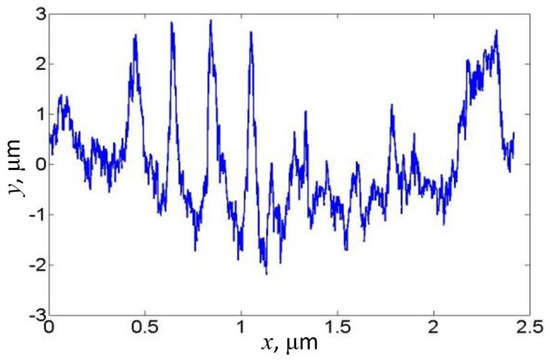
Figure 3.
Profile of heights of the titanium surface irradiated with plasma in PLM device [1].
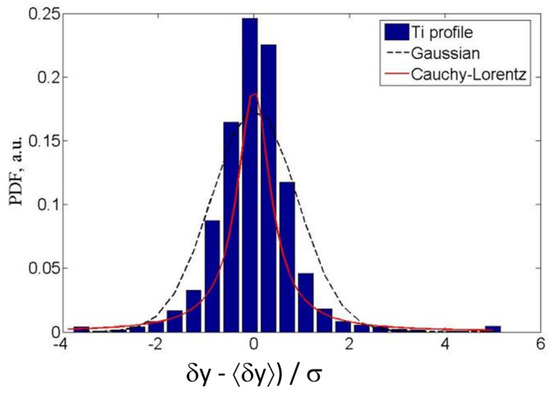
Figure 4.
PDF of the profile heights of titanium surface irradiated with plasma in PLM device [40]. The Gaussian (dotted line) and the Cauchy-Lorentz (solid line) laws are shown for comparison.
The statistical scale invariance (a self-similarity) of the surface topology is described by scaling of the structure-function, multifractal spectra, and the Hurst exponent [1,41]. The Hurst exponents for stochastic surface reliefs of titanium, tungsten, lithium, carbon, and beryllium are from 0.55 to 0.9 [1]. Such values of H > 0.5 mean a persistent behavior (trend). The fractal dimension df of the surface is related to the Hurst exponent H as H = 3 − df, see [3]. It corresponds to irregular stochastic clustering with hierarchical granularity (fractality), e.g., the cauliflower-like shape of the surface structure (see above). Hurst exponents from 0.55 to 0.9 correspond to the fractal dimension of the surface df = 2.1–2.45.
The property of statistical inhomogeneity is characterized by multifractality indices [41] as well. The multifractality index for the relief profiles of the samples from fusion devices is in the range of 0.5–1.2, illustrating a deviation of their structural complexity from the trivial stochasticity of the Brownian surface (for Brownian surface, this index is equal to 0). Quantitative characteristics of the statistical heterogeneity of the structure of materials of fusion devices, including the multifractality, are typical for multifractal objects and processes in nature (see [42]).
2.3.2. Fuzz-like Surfaces
Irradiation with helium plasma of tungsten and other metals in several linear fusion devices (NAGDIS-II, PLM, PISCES, and others), layers with a fuzz-type structure were found (see examples in Figure 5 and Figure 6). For the first time, such tungsten surfaces were detected in the NAGDIS-II device [43,44,45,46], then in other plasma devices—PLM [47,48], Pilot-PSI [49], and others [36,50,51,52,53,54,55]. Post-mortem scanning electron microscopy of such materials reveals a stochastic nanostructured surface with fibers of 20–50 nm in diameter. On the tungsten, the nanostructured fuzz layer depth is approximately 1.6 µm or more.
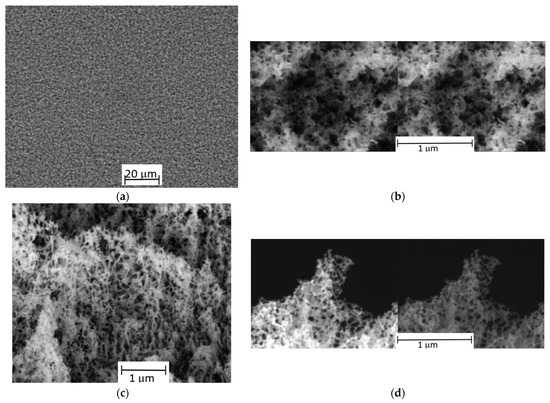
Figure 5.
SEM micrographs of “fuzz” layer on tungsten irradiated in PLM: (a–c) surface (d) cross-section.
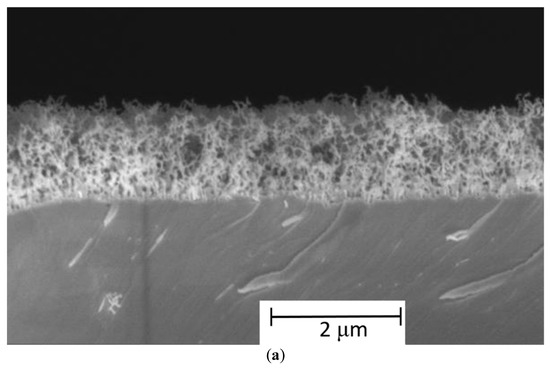
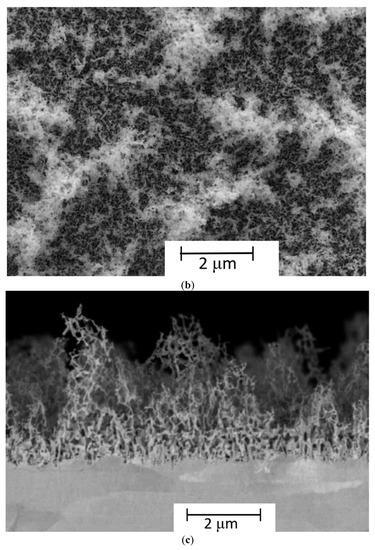
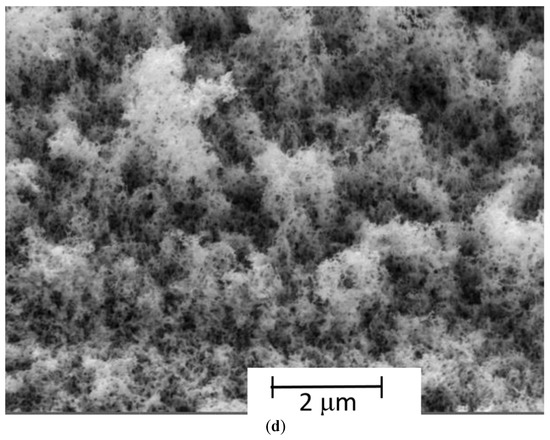
Figure 6.
SEM micrographs of the nanostructured “fuzz” surface on tungsten after irradiation with helium plasma in the PLM: (a) cross-section and (b) surface of dense “fuzz” structure; (c) cross-section and (d) surface of rare “fuzz” structure [47].
Such fuzz layers are formed during long-term irradiation with helium plasma for several tens of min (see review [36] and Refs. [37,43,44,45,46,47,48,49,50,51,52,53,54,55]). Plasma parameters required for the formation of nanostructured fuzz: plasma density is (1–10) × 1013 cm−3, the electron temperature is 1–10 eV, helium ion flux on the surface is 102–1024 m−2 s−1, the metal surface temperature is 400–1000 °C depending on the refractory metal.
The growth of fuzz in fusion devices was found on refractory metals-tungsten, molybdenum, titanium, noble metals, and others [36]. The example of fuzz on titanium is shown in Figure 7. The structure is similar to the fuzz layers on tungsten irradiated in the same device.
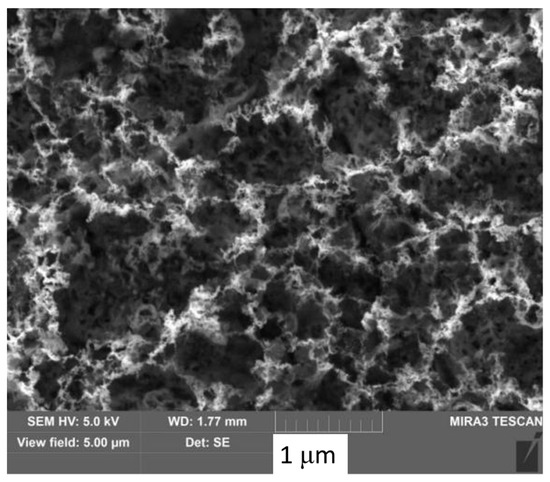
Figure 7.
SEM micrograph of “fuzz” layer on titanium after plasma irradiation in PLM-M plasma device.
The universality of the “fuzz” growth mechanism is explained in the model [56] considered the evolution of excited adatoms over a surface under high energy helium flux. Approving such theory, recently, the fiber density of the “fuzz” layer was observed to depend on the plasma load intensity: a dense “fuzz”-type structure and a rare “fuzz”-type structure were observed, see Figure 6 [47].
The fiber density of the “fuzz” layer depends on the plasma load: a dense “fuzz”-type structure, Figure 6a,b, and a rare fuzz-type structure Figure 6c,d is observed. The “fuzz” layer thickness is up to 1.5 microns, and the diameter of fibers is from ~20 nm to ~50 nm (Figure 5, Figure 6 and Figure 7) typically observed in experiments, see [57,58,59,60,61,62,63,64,65,66,67,68,69,70].
2.3.3. High-Porous Micro-Structured Surface
The structures described above are formed under special conditions of plasma load during a long time of plasma exposure. Under the action of additional factors of thermal or beam loading, highly porous surface structures can form, see the example in Figure 8, with a pore diameter and a pore depth from ~100 nm to ~10 microns. Such highly porous structures can be formed by the combined sequential treatment by beam loading on the material and then subsequently irradiated with high-temperature plasma in a plasma device. Such combined processing of refractory materials leads to the formation of a highly porous surface with pore sizes of micro- and nanometer diameter.
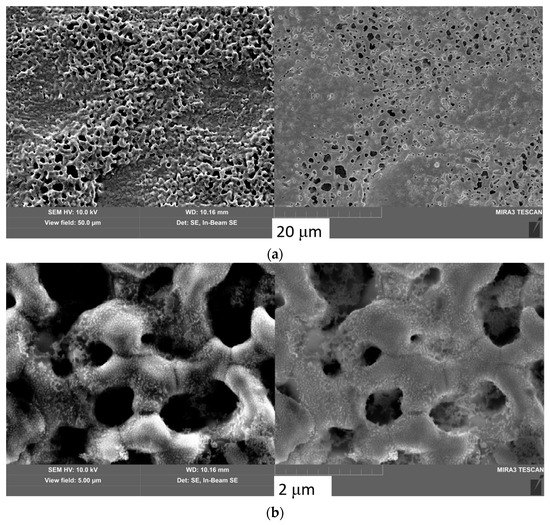
Figure 8.
SEM micrographs of the tungsten surface after combined irradiation with e-beam and subsequent plasma loads in PLM device. (a)—large-scale porous structure, (b)—small-scale porous structure.
Figure 8 shows an example of such a material: VM-P ITER-grade tungsten was treated using a combination of 40 MW/m2 electron beam thermal cycling and a subsequent stationary plasma load of up to 2 MW/m2 in a PLM plasma device. These combined treatments led to erosion, melting, and cracking of the material under the influence of an electron beam and the subsequent growth of a nanostructured fuzz structure on the surface of the material under the influence of a plasma load. Post-mortem scanning electron microscopy and X-ray analysis have shown size of pores and irregular structures less than 100 nm on the stochastic nanostructured surface. Fuzz-type structure of high porosity is observed. Conditions of such loads were as follows: electron beam loads near the melting point to obtain a corrugated surface and subsequent plasma irradiation to grow fuzz layers on the corrugated surface. As a result, a highly porous surface with a unique nanostructured surface is formed.
Another nanostructured surface formed under plasma load can be of a multi-cone type structure, see Figure 9. Steal samples irradiated with plasma in a PLM-M device demonstrate cones growth on the surface. During helium plasma irradiation, the steal surface temperature was ~450 °С. The plasma load in the stationary helium discharge in the PLM-M produced the surface growth of conical-type nanostructures of the cone size in the range from 20 nanometers to 500 nanometers.
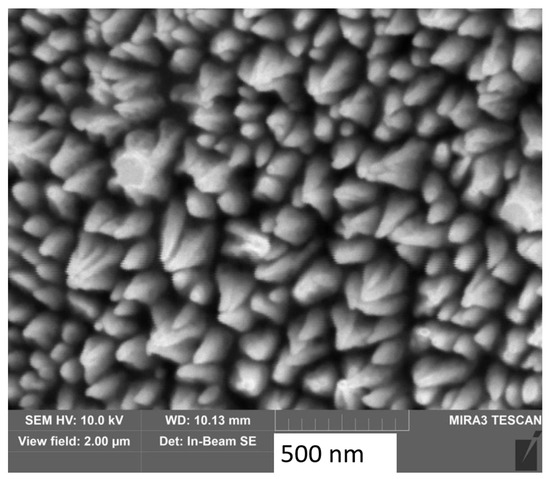
Figure 9.
The iron nanostructured surface formed under helium plasma in PLM-M plasma device [71].
2.3.4. Advantages of Practical Applications
The relevance of the technology for the production of highly porous refractory materials is discussed in the literature regarding the problem of catalysts [72,73,74,75,76,77,78]. The materials with a highly porous nanostructure described above and the method of their preparation by plasma irradiation have the potential for use as catalysts in the production of hydrogen. Materials mentioned above are potential for practical application as catalysts in hydrogen production. Highly porous titanium surfaces are candidates for bone implants, improving implant fixation and being well adapted to the human bone, see [79,80].
The practical application of fuzzy structures covering the surface is associated with a change in physical properties. Such materials can potentially be used in plasma and beam facilities as the first wall components interacting with plasma or beams. The surface area of nanostructured “fuzz” is 20–30 times larger than that of a flat surface [57,58,59]. From the point of view of the interaction of such a surface with the plasma flow, the sputtering rate decreases by about an order of magnitude [58,59,60], and the reflection of particles decreases, which leads to an increase in the power transfer coefficient [60].
In thermonuclear plasma devices, due to the nanostructure, arc ignition is expected in response to high-power plasma pulse load-like edge localized modes [68,69,70]. This process has both a disadvantage (associated with the enhanced erosion) and an advantage due to the possible effect of vapor plasma shielding effect.
The potential of the application of porous and fuzzy nanostructured materials is associated with a change in the properties of electronic emission. The field electron emission and the field enhancement factor increase [63], and thermal conductivity decreases significantly [64]. Secondary electron emission decreases by about 50%. Such materials absorb almost all photons in the spectrum from ultraviolet to near infrared (>99%) [65], and the optical emissivity is increased [66,67].
3. Heat Transfer on Surfaces Synthesized by Plasma
Currently, the development of many technologies determines the possibility of stable cooling and thermal stabilization of equipment components at high (up to 10 MW/m2) and ultra-high (more than 10 MW/m2) heat loads. This is due both to the high heat flux accompanying the processes (nuclear fusion devices, rocket nozzles, laser mirrors, etc.) and the need to reduce the heat exchange area in order to increase the efficiency of equipment used in the energy and chemical technologies and in the most rapidly developing technology of electronic components. Indeed, hundreds of laboratories around the world are engaged in the development of improved cooling methods. This issue was the most relevant in the heat transfer community over the past decade. Numerous new results have been obtained using primarily modern surface modification technologies in order to improve heat transfer characteristics. Because perceiving high and ultra-high heat fluxes at reasonable parameters is possible only with phase changes. Further the works performed under the conditions of boiling of heat carriers are considered. A distinctive feature of two-phase heat transfer from a single-phase one is the disproportionate improvement in heat transfer to the coefficient of development (increase) of the surface, the influence of many factors, and physical and chemical properties on the results obtained. As an example, Figure 10 shows data on the relative increase in critical heat fluxes (CHF, maximum heat flux density during nucleate boiling) depending on the coefficient of development (increased specific area) of the surface obtained by pool boiling of saturation water in some of the most cited experiments on modified surfaces [81]. As can be seen, the maximum increase is explained not by an increase in the heat exchange surface but precisely by the influence of a change in the characteristic properties of the surface. Currently, there is a competitive selection of technologies that allow obtaining the maximum intensification of heat transfer, and interest in the possibilities of surface modification by plasma treatment has a practical application.

Figure 10.
The relative increase in CHF depends on the surface development coefficient. Data from Refs.: triangles—[82], squares—[83], circles—[84], rhombuses—[85], crosses—[86].
It should be noted that the achievement of high values of CHF is the easiest when boiling a subcooled liquid on unmodified surfaces [87].
3.1. Methods for Enchantment Boiling Heat Transfer
At the turn of this century, new technical features have appeared primarily related to surface modification. The use of so-called nanofluids and nanomaterials, femtosecond laser exposure, and plasma and ion processing has made it possible to obtain a significant number of new results and caused a surge in relevant research. Traditionally, most of the studies have been carried out for pool boiling conditions in order to establish the main factors influencing this process and to find its general patterns. Further, the results are transferred to boiling in the flow and in the evaporation channels.
The following methods are used (see [88]):
- (1)
- influence of internal mechanisms (increase in evaporation centers, increase in the inflow of liquid into the evaporation zone of the microlayer, regulation of wettability, etc.)
- (2)
- increase/development of the heat exchange surface area;
- (3)
- creation of suppression of the least efficient processes during boiling, which ensures the removal of steam from the wall (including boiling in a highly subcooled liquid, alternation of zones with different wettability, etc.).
Above listed methods are often combined during implementation. Increasing the heat exchange surface area several times and simultaneously creating artificial centers of vaporization and increasing the flow of liquid into the evaporation zone can be used. The heat transfer during boiling is accompanied by the nucleation of a bubble on the wall, then by the growth of its volume due to the evaporation of the liquid upon contact with the wall and the entrainment of the vapor phase. The main mechanism in nucleate boiling is precisely evaporation in the microlayer near the zone contact with the wall.
Over the past two decades, numerous studies have been carried out to find improved conditions for enchantment boiling heat transfer on modified surfaces. The number of published articles on this topic is measured in thousands. It is impossible to provide a brief overview of the research. At the moment, several dozen (!) detailed reviews of the problem have already been published, see, e.g., [66,67,68,69,70,71], and is no longer a fantasy and the appearance of a review “reviews”. A large number of results have been obtained in laboratory experiments on surfaces approximately 1 cm by 1 cm in size on a significant intensification of heat transfer and CHF during boiling, as a rule, of water in a large volume at atmospheric pressure.
The most advanced and high-tech surface modification technologies (femtosecond laser ablation, microelectronics technologies, etc.) are used. With the use of surface modification, high rates of intensification of heat transfer and CHF were achieved up to 4–5 times in comparison with the unmodified surface. There are much fewer known studies devoted to the intensification of CHF during boiling in round tubes with a modified surface. The problems of thermal stabilization of modern and future microelectronic technology impose restrictions on the flow parameters and the type of coolant. Here the achievement of the required CHF is possible only when using the intensification of two-phase transfer processes.
Surface modification methods and materials used are systematized in [89]. They are as follows:
- Method of nanoscale surface modification, such as coating a substrate with metal nanoparticles, metal oxide, ceramics, carbon-based nanoparticles (carbon nanotubes, graphene), and nanowires;
- Surface modification at the microscale, such as the creation of microgrooves, micropin ribs, deposition of sintered particles, microgrid structure, microchannels of various shapes, and microcavities;
- Metals (Cu, Al, Zn, bronze, Mo, Si, gold), Metal-oxide (Al2O3, TiO2, ZrO2, CuO, BiO2, Fe2O3, Fe3O4, SiO2, ZnO), composite (Cu-Al2O3, GO–Cu, Cu-TiO2), carbon nanomaterial (graphene, diamond, single-walled CNT, multi-walled CNT SiC), nanowires (copper, silicon, TiO2);
- Various test heaters such as stainless steel, copper, copper alloy, aluminum, aluminum alloy, silicon, glass, titanium, bronze, zirconium, zirconium alloy, nickel wire, Ni-Cr wire, Pt wire, and Ti wire have been used;
- Deposition methods such as CVD, ECD, electron beam PVD, electron beam evaporator, dry or chemical etching, atomic layer deposition, lithography, UV radiation, sputtering, pulse laser deposition, nanofluid boiling, free particles, particle sintering, spray coating, spin coating, epoxy binding, dipping and dripping, thermal annealing, sonification, hummer technique were used to deposit on test surface metal, metal oxide, composite and carbon nanomaterials;
- Electric discharge machining (EDM), mechanic machining, wire EDM laser machining, end milling, rolling, polishing, selective laser melting, sintering, orthogonal Ploughing/Extrusion, wire cutting, anodization, photolithography, dry etching, chemical etching was used as methods to fabricate the microgrooves, pin-fin array, and tunnel structured surface.
The main conclusions from numerous works and reviews [88,89,90,91,92,93,94] for the implementation of the conditions for surface modification, where the greatest intensification of heat transfer and CHF have been achieved, are the following:
- -
- the existence of a multiscale structure of the modified surface, combining nano, micro, and meso “roughness”;
- -
- the porosity of the structure, providing the action of capillary forces;
- -
- application of modification technologies that provide zones with contrasting physical and chemical properties (wettability, thermal conductivity).
It is obvious that all these conditions can be realized using the plasma exposure technologies presented above. Due to a large number of influencing factors, it is very difficult to predict the surface structure that gives the maximum effect. The experimental verification of the intensification of heat transfer and CHF is necessary. In addition, for a number of highly porous surfaces, an improvement in heat transfer was noted due to the retention of vapor and gas in the pores but the deterioration of the CHF due to the rapid “steaming” of the surface.
3.2. Modification of the Heat Transfer Surface by Plasma
Plasma modification of surface is proposed in a large number of technologies. Currently, technologies have been developed using low-temperature plasma for various applications (disinfection, nanotechnology, food production, improvement of the properties of metals, plastics, membranes, etc.) [95,96,97,98,99,100].
Low-temperature plasma technique is used for material processing and modification at temperatures below 200 °C [96]. Low-temperature plasma can modify the property of the material surface and simultaneously maintain material structures. It is important, especially for temperature-sensitive materials. Working gases Ar, N2, O2, H2, and air are used in low-temperature plasma facilities. No harmful substances such as acid, alkali or organic solvent are used. Moreover, the effect on material surface properties can be efficiently tuned by plasma irradiation conditions such as power, treatment duration, and working gas.
To solve the problem of heat transfer intensification, the use of low-temperature plasma has a few examples [100,101,102,103,104]. The use of low-temperature plasma when modifying a heat exchange surface makes it possible to change the physicochemical properties of surfaces, primarily wettability, which has a significant effect on the intensification of boiling and condensation. The change in the physicochemical properties of the surface is due to oxidation. The coating with atmospheric pressure plasma was used to modify the surface of the copper heating block [105]. Gaseous nitrogen enters the upper grounded electrode, the lower electrode with a high-voltage power supply and is covered with a dielectric layer. The plasma spray with a temperature of 25–30 °C is formed and blown into the volume. Thus, thermal damage of treated materials is avoided. The static contact angle of the modified surface is 18°, which is around 60° of contact angle reduction compared to that of the untreated original copper surface (80°). The thickness of the oxide layer on the copper surface reaches approximately 3 μm at a plasma treatment time of 400 s. The CHF value improves by 18% after plasma treatment of the heating surface. The reason for the increase in CHF is related to the change in the wettability of the heating surface after plasma treatment.
In [101], the intensification of drop condensation was studied. In order to enhance condensation in the droplet mode, thin coatings (<100 nm) with low surface energy and with a small contact angle hysteresis, are used. Ultra-thin (<5 nm) silane self-assembling monolayers (or SAMs) have been studied to reveal the effects of droplet condensation due to their minimal thermal resistance. Such thin coatings decompose within an hour when water vapor condenses. After the destruction of the coating, the condensation of water vapor passes into an inefficient film regime with low heat transfer. In [101], the quality and durability of silane SAM under conditions of water vapor condensation on the copper surface were improved in comparison with silane coatings on metal surfaces using oxygen plasma treatment. The resulting SAM silane has a low contact angle hysteresis (≈20°), which ensures efficient droplet condensation of water for >360 h, with no destruction/degradation of the coating. Moreover, over a long period of time, it was demonstrated an increase in heat transfer by 5–7 times compared to film condensation. After condensation, the SAM silane is hypothesized to decompose due to the reduction and subsequent dissolution of the copper oxide at the oligomer-substrate interface.
SiO2-like hydrophilic and polymer-like hydrophobic SiOxCyHz films [103] at atmospheric pressure in the presence/absence of O2 are deposited by the plasma method on the copper surface from the vapor phase. Pool boiling experiments were performed on treated surfaces under atmospheric saturation conditions. The effects of surface modifications on CHF, nucleate boiling onset (ONB), and heat transfer coefficient (HTC) were investigated. It has been found that hydrophilic films deposited on surfaces lead to a significant increase in CHF and HTC compared to untreated surfaces. A reduction in up to 53% of the ONB of hydrophobic films deposited on copper surfaces was registered. Summarizing the experiment, the CHF values of bare, hydrophilic, and hydrophobic copper surfaces are 1539.9, 1798.8, and 593.1 kW/m2, respectively. The results show that for hydrophilic surfaces, the CHF threshold is increased by 16.8%, and for hydrophobic surfaces, CHF is reduced to 62% compared to bare surfaces. Changes in surface morphology and contact angles due to plasma treatment led to comparable changes in bubble ejection and in CHF. The hydrophilic coating delays the CHF due to small contact angles, which is an advantage of the hydrophilic coating.
High-temperature plasma is used for surface modification much less frequently than low-temperature plasma. For heat transfer conditions during phase transitions, only a few works are known. Heat transfer during boiling in a pool on capillary-porous coatings was studied for heat carriers of water and liquid nitrogen at atmospheric pressure [103]. Unique capillary-porous coatings of various thicknesses (400–1390 µm) with high porosity (up to 60%) were obtained by plasma spraying. At low heat fluxes, capillary-porous coatings cause a significant increase in heat transfer up to 4 times when boiling liquid nitrogen and up to 3.5 times when boiling water. The high-speed video showed that the mechanisms of heat transfer enhancement differ significantly depending on the properties of the liquid and the morphology of the coatings. The study of a capillary-porous coating obtained by plasma spraying in [104] revealed the effect of structured coatings on cryogenic quenching by a falling liquid nitrogen film. Experiments on cryogenic hardening were carried out on a vertical copper plate with a bare surface and on surfaces with different orientations of the coating protrusions. Features of the dynamics of the hardening front and heat transfer in the transition process affect heat transfer. The characteristics of heat transfer during hardening were measured for various surfaces, and experimental cooling thermograms and visualization were analyzed. The results have shown that the thermal properties of the coating and the geometry of the protrusions on the solid surface affect the cooling rate. The capillary-porous coating significantly affects the dynamics of hardening, which leads to a decrease in the total hardening time by more than three times. As a result, the structured capillary-porous coating provides a reduction in the total mass of the cryogenic liquid and the time required for the quenching process.
Modification by high-temperature plasma makes it possible to obtain unique surface structures (see Section 1). It opens new opportunities for significant intensification of two-phase heat transfer. It was demonstrated recently in experiments with a high-porous surface modified by high-temperature plasma in the PLM plasma device [81,106]. The study of pool boiling on the surface treated by PLM plasma resulted in new achievements in HTC. In such experiments, an iron sample (stainless steel) was processed in PLM by exposing the surface to helium plasma for 3 h at a surface temperature of 850 °C and a thermal load of 180 kW/m2. The modified surface has an almost regular structure of cones with an angle of 20°, a height of up to 12 µm, and a base diameter of 3 µm (Figure 11a). The surface of the cones has a porous structure (Figure 11b). A highly porous structure with a characteristic pore size of 100 nm is present at the bases of the cones. For this surface, an increase in the HTC by up to 40% was obtained compared to the unmodified surface. The comparison results are shown in Figure 12 [81]. A slight decrease in the CHF was registered for this surface, which is typical for material with a highly porous structure.
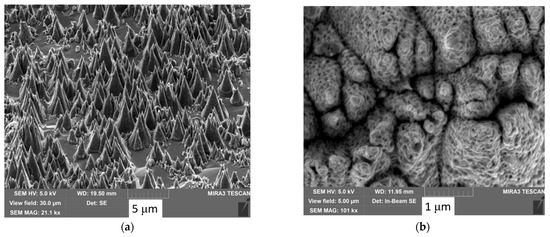
Figure 11.
SEM images of the iron sample (stainless steel) surface after plasma processing in a PLM device.(a)—cones, (b)—porous structure of cones.
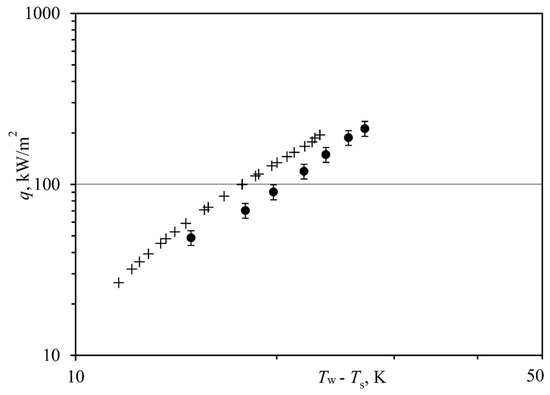
Figure 12.
Boiling curves R-113 at atmospheric pressure and saturated conditions [81] (●—Unmodified surface of the steel, +—Modified stainless steel surface shown in Figure 11).
3.3. Discussion and Advantages of Practical Applications
Plasma treatment of materials is an appropriate method for producing a rough surface with a high specific area. Using the control of the plasma load on the material, providing erosion, redeposition and resolidification after surface melting, it is possible to produce a surface with a different roughness topology. In studies of intensification of two-phase heat transfer, until recently, low-temperature plasma was mainly used to obtain a surface with a rough and developed structure. Getting enough materials treated with hot plasma in thermonuclear devices was restrictive. Studies of recently obtained samples treated with hot plasma in thermonuclear devices have demonstrated their effectiveness as a surface for heat transfer intensification. Currently, materials with a rough surface treated by high-temperature plasma can be produced in sufficient quantities in linear plasma devices constructed recently [35,36,37,38,59].
Surface treatment with low-temperature plasma leads to a change in the physical and chemical properties, mainly of the thin surface layer of several tens of nanometers. In contrast, irradiation with hot plasma makes it possible to obtain a developed rough surface relief to a depth of up to hundreds of microns or more. The advantage of such relief is also the presence of peaks of various scales on the surface and the property of self-similarity of the topology, which presumably has a positive effect on heat exchange. A change in the contact angle with the surface provides an increase in up to seven times in the heat transfer coefficient during condensation [101], which, in terms of the degree of influence on the process, exceeds the known results obtained using relief produced with non-plasma methods. In this case, unlike many other methods, long-term preservation of the working properties of the surface is ensured according to the data [101]. Exposure to plasma to modify the surface is possible in facilities such as plasma torches [103,104,107] and special plasma facilities, for example [81,105].
The advantages of the practical application of the surface treated with plasma [81,103,104,107], in comparison with surface modification by other methods (see reviews [88,89,90,91,92,93,94,108,109,110]), are high rates of intensification of heat transfer and CHF achieved (up to four times) in comparison with the unmodified surface. Surface treatment by high-temperature plasma makes it possible to form a surface structure that is resistant to degradation, especially using refractory metals in special heat exchange devices.
In order to choose a specific surface modification technology for practical use, the following issues should be taken into account: the possibility of implementing the technology, the surface material, and the operating temperature range.
4. Conclusions
The use of low-temperature plasma exposure makes it possible to form stable hydrophobic coatings, which opens up great opportunities to develop highly efficient condensers. The use of high-temperature plasma allows obtaining of unique rough surfaces that are potentially in demand for the intensification of heat transfer during phase changes.
Experiments in fusion plasma devices provide a powerful plasma-thermal load from 0.1 to 10 MW/m2 on the plasma-facing materials. The treatment of metals with high-temperature plasma in fusion devices leads to the growth of nanostructured surfaces, breaking the symmetry of the virgin surface of the initial crystalline material. The surfaces of cauliflower-like, “fuzz”-type structures and high porosity surfaces are growing under plasma load in fusion devices. The specific structure of such surfaces, such as 20–50 nanometers fibers of fuzzy structure, and fractal structure of cauliflower-like surfaces, are unique and cannot be grown under other conditions except high-temperature plasma processing under conditions other than high-temperature plasma treatment. Such nanostructured surfaces grow on tungsten, molybdenum, titanium, steel, and other metals. Refractory metals with a highly porous rough surface after high-temperature plasma treatment can be used as components for operation under extreme thermal and plasma loads in thermonuclear and nuclear reactors, as catalysts for hydrogen production, as well as in biotechnology and biomedical applications.
The advantages of the practical application of the surface treated with plasma are high rates of intensification of heat transfer and CHF achieved (up to four times) in comparison with the unmodified surface. Surface treatment by high-temperature plasma makes it possible to form a surface structure that is resistant to degradation, especially using refractory metals in special heat exchange devices. In order to choose a specific surface modification technology for practical use, the following issues should be taken into account: the possibility of implementing the technology, the surface material, and the operating temperature range.
Further studies of heat transfer on surfaces produced by high-temperature plasma are needed to achieve significant intensification of two-phase heat transfer.
Author Contributions
Conceptualization, A.V.D. and V.P.B.; methodology, A.V.D.; software, V.P.B.; validation, A.V.D. and V.P.B.; formal analysis, A.V.D. and V.P.B.; investigation, A.V.D. and V.P.B.; resources, A.V.D. and V.P.B.; data curation, A.V.D. and V.P.B.; writing—original draft preparation, V.P.B.; writing—review and editing, V.P.B. All authors have read and agreed to the published version of the manuscript.
Funding
This research was funded by the Russian Science Foundation grant No. 19-19-00410 in the part of heat transfer experiments. The material tests with e-beam were funded by the Russian Foundation for Basic Research grant No. 19-29-02020, analysis of materials was funded by the Ministry of Science and Higher Education of the Russian Federation grant FSWF-2020-0023.
Conflicts of Interest
The authors declare no conflict of interest.
References
- Budaev, V.P. Scale Symmetry of Stochastic Surface Clustering under Plasma Influence in Fusion Devices. Symmetry 2021, 13, 796. [Google Scholar] [CrossRef]
- Budaev, V.P. Stochastic clustering of material surface under high-heat plasma load. Phys. Lett. A 2017, 381, 3706–3713. [Google Scholar] [CrossRef]
- Budaev, V.P.; Grashin, S.A.; Karpov, A.V.; Kraevskii, S.V.; Khimchenko, L.N. Long-range correlations in the structure of fractal films. JETP Lett. 2012, 95, 78–84. [Google Scholar] [CrossRef]
- Kadomtsev, B.B. Tokamak Plasma: A Complex Physical System; IOP Publishing: Bristol, UK; Philadelphia, PA, USA, 1992. [Google Scholar]
- Budaev, V.P.; Savin, S.P.; Zelenyi, L.M. Investigation of intermittency and generalized self-similarity of turbulent boundary layers in laboratory and magnetospheric plasmas: Towards a quantitative definition of plasma transport features. Phys.-Uspekhi 2011, 54, 875. [Google Scholar] [CrossRef]
- Budaev, V.P.; Zelenyi, L.M.; Savin, S.P. Generalized Self-Similarity of Intermittent Plasma Turbulence in Space and Laboratory Plasmas. J. Plasma Phys. 2015, 81, 395810602. [Google Scholar] [CrossRef]
- Pitts, R.; Carpentier, S.; Escourbiac, F.; Hirai, T.; Komarov, V.; Kukushkin, A.; Lisgo, S.; Loarte, A.; Merola, M.; Mitteau, R.; et al. Physics basis and design of the ITER plasma-facing components. J. Nucl. Mater. 2011, 415, S957–S964. [Google Scholar] [CrossRef]
- Federici, G.; Skinner, C.; Brooks, J.; Coad, J.; Grisolia, C.; Haasz, A.; Hassanein, A.; Philipps, V.; Pitcher, C.; Roth, J.; et al. Plasma-material interactions in current tokamaks and their implications for next step fusion reactors. Nucl. Fusion 2001, 41, 1967–2137. [Google Scholar] [CrossRef]
- Budaev, V.P. Results of high heat flux tests of tungsten divertor targets under plasma heat loads expected in ITER and tokamaks (review). Phys. At. Nucl. 2016, 79, 1137–1162. [Google Scholar] [CrossRef]
- Budaev, V.P.; Takamura, S.; Ohno, N.; Masuzaki, S. Superdiffusion and multifractal statistics of edge plasma turbulence in fusion devices. Nucl. Fusion 2006, 46, S181–S191. [Google Scholar] [CrossRef]
- Budaev, V.P.; Kikuchi, Y.; Uesugi, Y.; Takamura, S. Effect of rotating helical magnetic field on the turbulence fractal structure and transport in the tokamak edge plasma. Nucl. Fusion 2004, 44, S108–S117. [Google Scholar] [CrossRef]
- Moyer, R.A.; Lehmer, R.D.; Evans, T.E.; Conn, R.W.; Schmitz, L. Nonlinear analysis of turbulence across the L to H transition. Plasma Phys. Control. Fusion 1996, 38, 1273–1278. [Google Scholar] [CrossRef]
- Budaev, V.P.; Savin, S.; Zelenyi, L.; Ohno, N.; Takamura, S.; Amata, E. Intermittency and extended self-similarity in space and fusion plasma: Boundary effects. Plasma Phys. Control. Fusion 2008, 50, 074014. [Google Scholar] [CrossRef]
- Budaev, V.P. Generalized Self-Similarity of Edge Plasma Turbulence in Fusion Devices. Contrib. Plasma Phys. 2010, 50, 218–227. [Google Scholar] [CrossRef]
- Muzy, J.F.; Delour, J.; Bacry, E. Modelling fluctuations of financial time series: From cascade process to stochastic volatility model. Eur. Phys. J. B 2000, 17, 537–548. [Google Scholar] [CrossRef]
- Barabasi, A.L.; Stanley, H.E. Fractal Concepts in Surface Growth; Cambridge University Press: Cambridge, UK, 1995. [Google Scholar]
- Kardar, M.; Parisi, G.; Zhang, Y.-C. Dynamic Scaling of Growing Interfaces. Phys. Rev. Lett. 1986, 56, 889–892. [Google Scholar] [CrossRef] [PubMed]
- Zhang, Y.-C. Non-universal roughening of kinetic self-affine interfaces. J. Phys. 1990, 51, 2129–2134. [Google Scholar] [CrossRef]
- Smoluchowski, M.V. Versuch einer mathematischen Theorie der Koagulationskinetik kolloider Lösungen. Z. Phys. Chem. 1918, 92, 129–168. [Google Scholar] [CrossRef]
- Voloshchuk, V.M. Kinetic Theory of Coagulation; Gidrometeoizdat: Leningrad, Russia, 1984. [Google Scholar]
- Kolmogorov, A.N. The local structure of turbulence in incompressible viscous fluid for very large Reynolds number. Dokl. Akad. Nauk. SSSR 1941, 30, 299–303. [Google Scholar]
- Zakharov, V.E.; Filonenko, N.N. Weak turbulence of capillary waves. J. Appl. Mech. Tech. Phys. 1971, 8, 37–40. [Google Scholar] [CrossRef]
- Zakharov, V.E.; Filonenko, N.N. Energy spectrum for stochastic oscillations of the surface of a liquid. Sov. Phys. Dokl. 1967, 11, 881–884. [Google Scholar]
- Ma, D.; Stoica, A.D.; Wang, X.-L. Power-law scaling and fractal nature of medium-range order in metallic glasses. Nat. Mater. 2009, 8, 30–34. [Google Scholar] [CrossRef] [PubMed]
- Fratini, M.; Poccia, N.; Ricci, A.; Campi, G.; Burghammer, M.; Aeppli, G.; Bianconi, A. Scale-free structural organization of oxygen interstitials in La2CuO4+y. Nature 2010, 466, 841–844. [Google Scholar] [CrossRef] [PubMed]
- Brezinsek, S.; Kirschner, A.; Mayer, M.; Baron-Wiechec, A.; Borodkina, I.; Borodin, D.; Coffey, I.; Coenen, J.; Harder, N.D.; Eksaeva, A.; et al. Erosion, screening, and migration of tungsten in the JET divertor. Nucl. Fusion 2019, 59, 096035. [Google Scholar] [CrossRef]
- Masuzaki, S.; Tokitani, M.; Otsuka, T.; Oya, Y.; Hatano, Y.; Miyamoto, M.; Sakamoto, R.; Ashikawa, N.; Sakurada, S.; Uemura, Y.; et al. Analyses of microstructure, composition and retention of hydrogen isotopes in divertor tiles of JET with the ITER-like wall. Phys. Scr. 2017, T170, 014031. [Google Scholar] [CrossRef]
- De Temmerman, G.; Hirai, T.; Pitts, R.A. The influence of plasma-surface interaction on the performance of tungsten at the ITER divertor vertical targets. Plasma Phys. Control. Fusion 2018, 60, 044018. [Google Scholar] [CrossRef]
- Grashin, S.; Arkhipov, I.; Budaev, V.P.; Karpov, A.; Klyuchnikov, L.; Khimchenko, L.; Melnikov, A.; Sarychev, D.; Sergeev, N.; Zemtsov, I. ITER-grade tungsten limiters damage under high turbulent heat flux in the T-10 tokamak. Fusion Eng. Des. 2019, 146, 2100–2104. [Google Scholar] [CrossRef]
- Ueda, Y.; Coenen, J.; De Temmerman, G.; Doerner, R.; Linke, J.; Philipps, V.; Tsitrone, E. Research status and issues of tungsten plasma facing materials for ITER and beyond. Fusion Eng. Des. 2014, 89, 901–906. [Google Scholar] [CrossRef]
- Budaev, V.P.; Khimchenko, L.N. Fractal growth of deposited films in tokamaks. Phys. A Stat. Mech. Its Appl. 2007, 382, 359–377. [Google Scholar] [CrossRef]
- Budaev, V.P.; Khimchenko, L.N. Fractal structure of films deposited in a tokamak. J. Exp. Theor. Phys. 2007, 104, 629–643. [Google Scholar] [CrossRef]
- Hirai, T.; Escourbiac, F.; Barabash, V.; Durocher, A.; Fedosov, A.; Ferrand, L.; Jokinen, T.; Komarov, V.; Merola, M.; Carpentier-Chouchana, S.; et al. Status of technology R&D for the ITER tungsten divertor monoblock. J. Nucl. Mater. 2015, 463, 1248–1251. [Google Scholar] [CrossRef]
- Zhitlukhin, A.; Klimov, N.; Landman, I.; Linke, J.; Loarte, A.; Merola, M.; Podkovyrov, V.; Federici, G.; Bazylev, B.; Pestchanyi, S.; et al. Effects of ELMs on ITER divertor armour materials. J. Nucl. Mater. 2007, 363–365, 301–307. [Google Scholar] [CrossRef]
- De Temmerman, G.; van den Berg, M.; Scholten, J.; Lof, A.; van der Meiden, H.; van Eck, H.; Morgan, T.; de Kruijf, T.; van Emmichoven, P.Z.; Zielinski, J. High heat flux capabilities of the Magnum-PSI linear plasma device. Fusion Eng. Des. 2013, 88, 483–487. [Google Scholar] [CrossRef][Green Version]
- Kajita, S.; Kawaguchi, S.; Ohno, N.; Yoshida, N. Enhanced growth of large-scale nanostructures with metallic ion precipitation in helium plasmas. Sci. Rep. 2018, 8, 56. [Google Scholar] [CrossRef] [PubMed]
- Kajita, S.; Tanaka, H.; Ohno, N. Tailoring of fuzzy nanostructures on porous tungsten skeleton by helium plasma irradiation. Jpn. J. Appl. Phys. 2017, 56, 030303. [Google Scholar] [CrossRef]
- Budaev, V.P.; Fedorovich, S.D.; Martynenko, Y.V.; Lukashevsky, M.V.; Gubkin, M.K.; Lazukin, A.V.; Karpov, A.V.; Shestakov, E.A. The plasma device for the high-heat plasma testing of refractory metals and inventing of new highly porous materials. J. Phys. Conf. Ser. 2017, 891, 012304. [Google Scholar] [CrossRef]
- Budaev, V.P.; Fedorovich, S.; Lubenchenko, A.; Karpov, A.; Belova, N.; Gubkin, M. Spectroscopic characterization of composite lithium materials irradiated with high-temperature plasma. Heliyon 2020, 6, e05510. [Google Scholar] [CrossRef]
- Budaev, V.P.; Fedorovich, S.D.; Martynenko, Y.V.; Egorikhina, M.N.; Karpov, A.V.; Lukashevsky, M.V.; Gubkin, M.K.; Budaeva, M.V.; Lazukin, A.V.; Aleynik, D.Y.; et al. Plasma technology for creating highly porous titanium materials for biomedical applications. In Proceedings of the XXIV Conference “Plasma-Surface Interaction”, Moscow, Russia, 4–5 January 2021; NRU MEPhI: Moscow, Russia, 2021; p. 63, ISBN 978-5-7262-2741-2. (In Russian). [Google Scholar]
- Muzy, J.F.; Bacry, E.; Arneodo, A. Wavelets and multifractal formalism for singular signals: Application to turbulence data. Phys. Rev. Lett. 1991, 67, 3515–3518. [Google Scholar] [CrossRef]
- Bacry, E.; Muzy, J.F.; Arnéodo, A. Singularity spectrum of fractal signals from wavelet analysis: Exact results. J. Stat. Phys. 1993, 70, 635–674. [Google Scholar] [CrossRef]
- Takamura, S. Initial Stage of Fiber-Form Nanostructure Growth on Refractory Metal Surfaces with Helium Plasma Irradiation. Plasma Fusion Res. 2014, 9, 1302007. [Google Scholar] [CrossRef]
- Nishijima, D.; Ye, M.; Ohno, N.; Takamura, S. Incident ion energy dependence of bubble formation on tungsten surface with low energy and high flux helium plasma irradiation. J. Nucl. Mater. 2003, 313–316, 97–101. [Google Scholar] [CrossRef]
- Nishijima, D.; Ye, M.; Ohno, N.; Takamura, S. Formation mechanism of bubbles and holes on tungsten surface with low-energy and high-flux helium plasma irradiation in NAGDIS-II. J. Nucl. Mater. 2004, 329–333, 1029–1033. [Google Scholar] [CrossRef]
- Takamura, S.; Ohno, N.; Nishijima, D.; Kajita, S. Formation of Nanostructured Tungsten with Arborescent Shape due to Helium Plasma Irradiation. Plasma Fusion Res. 2006, 1, 051. [Google Scholar] [CrossRef]
- Budaev, V.P.; Fedorovich, S.; Dedov, A.; Martynenko, Y.; Frick, P.; Karpov, A.; Van Oost, G.; Lyublinsky, I.; Vertkov, A.; Lukashevsky, M.; et al. High-heat flux tests of fusion materials with stationary plasma in the PLM device. Fusion Eng. Des. 2020, 155, 111694. [Google Scholar] [CrossRef]
- Budaev, V.P.; Fedorovich, S.; Dedov, A.; Karpov, A.; Komov, A.; Martynenko, Y.; Giniyatulin, R.; Makhankov, A.; Litunovsky, N.; Sliva, A.; et al. High-heat flux tests of tungsten divertor mock-ups with steady-state plasma and e-beam. Nucl. Mater. Energy 2020, 25, 100816. [Google Scholar] [CrossRef]
- De Temmerman, G.; Bystrov, K.; Doerner, R.; Marot, L.; Wright, G.; Woller, K.; Whyte, D.; Zielinski, J. Helium effects on tungsten under fusion-relevant plasma loading conditions. J. Nucl. Mater. 2013, 438, S78–S83. [Google Scholar] [CrossRef]
- Baldwin, M.; Doerner, R. Helium induced nanoscopic morphology on tungsten under fusion relevant plasma conditions. Nucl. Fusion 2008, 48, 035001. [Google Scholar] [CrossRef]
- Baldwin, M.J.; Doerner, R.P. Formation of helium induced nanostructure ‘fuzz’ on various tungsten grades. J. Nucl. Mater. 2010, 404, 165–173. [Google Scholar] [CrossRef]
- Wright, G.; Brunner, D.; Baldwin, M.; Doerner, R.; LaBombard, B.; Lipschultz, B.; Terry, J.; Whyte, D. Tungsten nano-tendril growth in the Alcator C-Mod divertor. Nucl. Fusion 2012, 52, 042003. [Google Scholar] [CrossRef]
- Miyamoto, M.; Mikami, S.; Nagashima, H.; Iijima, N.; Nishijima, D.; Doerner, R.; Yoshida, N.; Watanabe, H.; Ueda, Y.; Sagara, A. Systematic investigation of the formation behavior of helium bubbles in tungsten. J. Nucl. Mater. 2015, 463, 333–336. [Google Scholar] [CrossRef]
- Ueda, Y.; Peng, H.; Lee, H.; Ohno, N.; Kajita, S.; Yoshida, N.; Doerner, R.; De Temmerman, G.; Alimov, V.; Wright, G. Helium effects on tungsten surface morphology and deuterium retention. J. Nucl. Mater. 2013, 442, S267–S272. [Google Scholar] [CrossRef]
- Kajita, S.; Nojima, T.; Okuyama, T.; Yamamoto, Y.; Yoshida, N.; Ohno, N. Helium plasma–induced straight nanofiber growth on HCP metals. Acta Mater. 2019, 181, 342–351. [Google Scholar] [CrossRef]
- Martynenko, Y.V.; Nagel’, M.Y. Model of fuzz formation on a tungsten surface. Plasma Phys. Rep. 2012, 38, 996–999. [Google Scholar] [CrossRef]
- Kajita, S.; Ishida, T.; Ohno, N.; Hwangbo, D.; Yoshida, T. Fuzzy nanostructure growth on Ta/Fe by He plasma irradiation. Sci. Rep. 2016, 6, 30380. [Google Scholar] [CrossRef] [PubMed]
- Kajita, S.; Kitaoka, D.; Ohno, N.; Yoshihara, R.; Yoshida, N.; Yoshida, T. Surface modification of titanium using He plasma. Appl. Surf. Sci. 2014, 303, 438–445. [Google Scholar] [CrossRef]
- Kajita, S.; Yoshida, N.; Ohno, N. Tungsten fuzz: Deposition effects and influence to fusion devices. Nucl. Mater. Energy 2020, 25, 100828. [Google Scholar] [CrossRef]
- Takamura, S.; Miyamoto, T.; Ohno, N. Power Transmission Factor for Tungsten Target w/wo Fiber-Form Nanostructure in He Plasmas with Hot Electron Component Using Compact Plasma Device AIT-PID. Fusion Sci. Technol. 2013, 63, 225–228. [Google Scholar] [CrossRef]
- Takamura, S.; Miyamoto, T.; Ohno, N. Deepening of Floating Potential for Tungsten Target Plate on the way to Nanostructure Formation. Plasma Fusion Res. 2010, 5, 039. [Google Scholar] [CrossRef]
- Patino, M.; Raitses, Y.; Wirz, R. Secondary electron emission from plasma-generated nanostructured tungsten fuzz. Appl. Phys. Lett. 2016, 109, 201602. [Google Scholar] [CrossRef]
- Hwangbo, D.; Kajita, S.; Ohno, N.; Sinelnikov, D. Field Emission from Metal Surfaces Irradiated with Helium Plasmas. IEEE Trans. Plasma Sci. 2017, 45, 2080–2086. [Google Scholar] [CrossRef]
- Kajita, S.; Yagi, T.; Kobayashi, K.; Tokitani, M.; Ohno, N. Measurement of heat diffusion across fuzzy tungsten layer. Results Phys. 2016, 6, 877–878. [Google Scholar] [CrossRef]
- Kajita, S.; Saeki, T.; Yoshida, N.; Ohno, N.; Iwamae, A. Nanostructured Black Metal: Novel Fabrication Method by Use of Self-Growing Helium Bubbles. Appl. Phys. Express 2010, 3, 085204. [Google Scholar] [CrossRef]
- Takamura, S.; Miyamoto, T.; Ohno, N. Effects of fibre-form nanostructures on particle emissions from a tungsten surface in plasmas. Nucl. Fusion 2012, 52, 123001. [Google Scholar] [CrossRef]
- Kajita, S.; Ohno, N.; Yokochi, T.; Yoshida, N.; Yoshihara, R.; Takamura, S.; Hatae, T. Optical properties of nanostructured tungsten in near infrared range. Plasma Phys. Control. Fusion 2012, 54, 105015. [Google Scholar] [CrossRef]
- Kajita, S.; Takamura, S.; Ohno, N. Prompt ignition of a unipolar arc on helium irradiated tungsten. Nucl. Fusion 2009, 49, 032002. [Google Scholar] [CrossRef]
- Tokitani, M.; Kajita, S.; Masuzaki, S.; Hirahata, Y.; Ohno, N.; Tanabe, T.; LHD Experiment Group. Exfoliation of the tungsten fibreform nanostructure by unipolar arcing in the LHD divertor plasma. Nucl. Fusion 2011, 51, 102001. [Google Scholar] [CrossRef]
- Matějíček, J.; Weinzettl, V.; Vilémová, M.; Morgan, T.W.; De Temmerman, G.; Dimitrova, M.; Cavalier, J.; Adámek, J.; Seidl, J.; Jäger, A. ELM-induced arcing on tungsten fuzz in the COMPASS divertor region. J. Nucl. Mater. 2017, 492, 204–212. [Google Scholar] [CrossRef]
- Budaev, V.P. Stochastic Clustering Surfaces of Refractory Materials When Exposed to Plasma-Beam Streams; LAP Lambert Academic Publishing: Saarbrucken, Germany, 2020; p. 152. (In Russian) [Google Scholar]
- Huang, L.-Y.; Huang, J.-F.; Lei, Y.; Qin, S.; Liu, J.-M. Porous Hybrid Materials Based on Mesotetrakis(Hydroxyphenyl) Porphyrins and TiO2 for Efficient Visible-Light-Driven Hydrogen Production. Catalysts 2020, 10, 656. [Google Scholar] [CrossRef]
- Chernyshev, A.A.; Nikitina, E.V. A Porous Tungsten Substrate for Catalytic Reduction of Hydrogen by Dealloying of a Tungsten–Rhenium Alloy in an Aqueous Solution of Hydrochloric Acid. Appl. Sci. 2022, 12, 1029. [Google Scholar] [CrossRef]
- Wang, X.-D.; Xu, Y.-F.; Rao, H.-S.; Xu, W.-J.; Chen, H.-Y.; Zhang, W.-X.; Kuang, D.-B.; Su, C.-Y. Novel porous molybdenum tungsten phosphide hybrid nanosheets on carbon cloth for efficient hydrogen evolution. Energy Environ. Sci. 2016, 9, 1468–1475. [Google Scholar] [CrossRef]
- Yadav, A.A.; Hunge, Y.M.; Kang, S.-W. Porous nanoplate-like tungsten trioxide/reduced graphene oxide catalyst for sonocatalytic degradation and photocatalytic hydrogen production. Surf. Interfaces 2021, 24, 101075. [Google Scholar] [CrossRef]
- Bentley, J.; Desai, S.; Bastakoti, B.P. Porous Tungsten Oxide: Recent Advances in Design, Synthesis, and Applications. Chem.–A Eur. J. 2021, 27, 9241–9252. [Google Scholar] [CrossRef] [PubMed]
- Zhang, X.; Wei, Y.; Yu, R. Multidimensional Tungsten Oxides for Efficient Solar Energy Conversion. Small Struct. 2021, 3, 2100130. [Google Scholar] [CrossRef]
- Tang, L.; Feng, Y.; Chen, W.; Zhang, Y.; Xi, X.; Gao, B.; Wang, J.; Wu, M. Morphology Controllable Fabrication of Tungsten Oxide for Enhanced Photocatalytic Performance. Catal. Surv. Asia 2021, 25, 334–345. [Google Scholar] [CrossRef]
- Bram, M.; Ebel, T.; Wolff, M.; Barbosa, A.P.C.; Tuncer, N. Applications of powder metallurgy in biomaterials. In Advances in Powder Metallurgy. Properties, Processing and Applications; Woodhead Publishing Series in Metals and Surface Engineering; Woodhead Publishing Limited: Cambridge, UK, 2013; pp. 520–554. [Google Scholar]
- Wang, R.; Ni, S.; Ma, L.; Li, M. Porous construction and surface modification of titanium-based materials for osteogenesis: A review. Front. Bioeng. Biotechnol. 2022, 10, 973297. [Google Scholar] [CrossRef]
- Dedov, A.V.; Khaziev, I.A.; Laharev, D.A.; Fedorovich, S.D. Study of Nucleate Pool Boiling Heat Transfer Enhancement on Surfaces Modified by Beam Technologies. Heat Transf. Eng. 2022, 43, 598–607. [Google Scholar] [CrossRef]
- Chu, K.-H.; Enright, R.; Wang, E.N. Structured surfaces for enhanced pool boiling heat transfer. Appl. Phys. Lett. 2012, 100, 241603. [Google Scholar] [CrossRef]
- Cooke, D.; Kandlikar, S.G. Pool Boiling Heat Transfer and Bubble Dynamics Over Plain and Enhanced Microchannels. J. Heat Transf. 2011, 133, 052902. [Google Scholar] [CrossRef]
- Rahman, M.M.; Ölçeroğlu, E.; McCarthy, M. Role of Wickability on the Critical Heat Flux of Structured Superhydrophilic Surfaces. Langmuir 2014, 30, 11225–11234. [Google Scholar] [CrossRef]
- Zou, A.; Maroo, S.C. Critical height of micro/nano structures for pool boiling heat transfer enhancement. Appl. Phys. Lett. 2013, 103, 221602. [Google Scholar] [CrossRef]
- Dhillon, N.S.; Buongiorno, J.; Varanasi, K.K. Critical heat flux maxima during boiling crisis on textured surfaces. Nat. Commun. 2015, 6, 8247. [Google Scholar] [CrossRef]
- Dedov, A.V. Peculiarities of boiling in subcooled flow. Therm. Eng. 2009, 56, 691–699. [Google Scholar] [CrossRef]
- Dedov, A.V. A Review of Modern Methods for Enhancing Nucleate Boiling Heat Transfer. Therm. Eng. 2019, 66, 881–915. [Google Scholar] [CrossRef]
- Singh, S.K.; Sharma, D. Review of pool and flow boiling heat transfer enhancement through surface modification. Int. J. Heat Mass Transf. 2021, 181, 122020. [Google Scholar] [CrossRef]
- Yuan, X.; Du, Y.; Su, J. Approaches and potentials for pool boiling enhancement with superhigh heat flux on responsive smart surfaces: A critical review. Renew. Sustain. Energy Rev. 2022, 156, 111974. [Google Scholar] [CrossRef]
- Nguyen, D.H.; Ahn, H.S. A comprehensive review on micro/nanoscale surface modification techniques for heat transfer enhancement in heat exchanger. Int. J. Heat Mass Transf. 2021, 178, 121601. [Google Scholar] [CrossRef]
- Devahdhanush, V.; Mudawar, I. Review of Critical Heat Flux (CHF) in Jet Impingement Boiling. Int. J. Heat Mass Transf. 2021, 169, 120893. [Google Scholar] [CrossRef]
- Liang, G.; Mudawar, I. Review of nanoscale boiling enhancement techniques and proposed systematic testing strategy to ensure cooling reliability and repeatability. Appl. Therm. Eng. 2021, 184, 115982. [Google Scholar] [CrossRef]
- Chen, J.; Ahmad, S.; Cai, J.; Liu, H.; Lau, K.T.; Zhao, J. Latest progress on nanotechnology aided boiling heat transfer enhancement: A review. Energy 2021, 215, 119114. [Google Scholar] [CrossRef]
- Basak, S.; Annapure, U.S. Recent trends in the application of cold plasma for the modification of plant proteins—A review. Future Foods 2022, 5, 100119. [Google Scholar] [CrossRef]
- Men, Y.-L.; Liu, P.; Meng, X.-Y.; Pan, Y.-X. Recent progresses in material fabrication and modification by cold plasma technique. FirePhysChem 2022, 2, 214–220. [Google Scholar] [CrossRef]
- He, J.; Wen, X.; Wu, L.; Chen, H.; Hu, J.; Hou, X. Dielectric barrier discharge plasma for nanomaterials: Fabrication, modification and analytical applications. TrAC Trends Anal. Chem. 2022, 156, 116715. [Google Scholar] [CrossRef]
- Subeshan, B.; Asmatulu, R. Corrosion mitigation of metals and alloys via superhydrophobic coatings with plasma surface and heat treatment processes. Eng. Fail. Anal. 2022, 139, 106437. [Google Scholar] [CrossRef]
- Gryta, M. Surface modification of polypropylene membrane by helium plasma treatment for membrane distillation. J. Membr. Sci. 2021, 628, 119265. [Google Scholar] [CrossRef]
- Kuzenov, V.; Ryzhkov, S. The Qualitative and Quantitative Study of Radiation Sources with a Model Configuration of the Electrode System. Symmetry 2021, 13, 927. [Google Scholar] [CrossRef]
- Wang, R.; Guo, J.; Muckleroy, E.A.; Antao, D.S. Robust silane self-assembled monolayer coatings on plasma-engineered copper surfaces promoting dropwise condensation. Int. J. Heat Mass Transf. 2022, 194, 123028. [Google Scholar] [CrossRef]
- Mohammadi, H.R.; Taghvaei, H.; Rabiee, A. Experimental study of pool boiling on hydrophilic and hydrophobic thin films deposited on copper surfaces using atmospheric cold plasma. Int. J. Therm. Sci. 2022, 175, 107474. [Google Scholar] [CrossRef]
- Surtaev, A.; Kuznetsov, D.; Serdyukov, V.; Pavlenko, A.; Kalita, V.; Komlev, D.; Ivannikov, A.; Radyuk, A. Structured capillary-porous coatings for enhancement of heat transfer at pool boiling. Appl. Therm. Eng. 2018, 133, 532–542. [Google Scholar] [CrossRef]
- Starodubtseva, I.; Kuznetsov, D.; Pavlenko, A. Experiments and modeling on cryogenic quenching enhancement by the structured capillary-porous coatings of surface. Int. J. Heat Mass Transf. 2021, 176, 121388. [Google Scholar] [CrossRef]
- Kim, S.J.; Zou, L.; Jones, B.G. An experimental study on sub-cooled flow boiling CHF of R134a at low pressure condition with atmospheric pressure (AP) plasma assisted surface modification. Int. J. Heat Mass Transf. 2015, 81, 362–372. [Google Scholar] [CrossRef]
- Fedorovich, S.D.; Dedov, A.V.; Khaziev, I.A. Creating heat exchange surfaces using laser, electronic, and plasma energy fluxes. High Temp. Mater. Process. 2021, 25, 81–93. [Google Scholar] [CrossRef]
- Surtaev, A.S.; Pavlenko, A.N.; Kuznetsov, D.V.; Kalita, V.I.; Komlev, D.I.; Ivannikov, A.Y.; Radyuk, A.A. Heat transfer and crisis phenomena at pool boiling of liquid nitrogen on the surfaces with capillary-porous coatings. Int. J. Heat Mass Transf. 2017, 108, 146–155. [Google Scholar] [CrossRef]
- Sun, Y.; Tang, Y.; Zhang, S.; Yuan, W.; Tang, H. A review on fabrication and pool boiling enhancement of three-dimensional complex structures. Renew. Sustain. Energy Rev. 2022, 162, 112437. [Google Scholar] [CrossRef]
- Chu, H.; Yu, X.; Jiang, H.; Wang, D.; Xu, N. Progress in enhanced pool boiling heat transfer on macro- and micro-structured surfaces. Int. J. Heat Mass Transf. 2022, 200, 123530. [Google Scholar] [CrossRef]
- Chu, H.; Xu, N.; Yu, X.; Jiang, H.; Ma, W.; Qiao, F. Review of surface modification in pool boiling application: Coating manufacturing process and heat transfer enhancement mechanism. Appl. Therm. Eng. 2022, 215, 119041. [Google Scholar] [CrossRef]
Publisher’s Note: MDPI stays neutral with regard to jurisdictional claims in published maps and institutional affiliations. |
© 2022 by the authors. Licensee MDPI, Basel, Switzerland. This article is an open access article distributed under the terms and conditions of the Creative Commons Attribution (CC BY) license (https://creativecommons.org/licenses/by/4.0/).